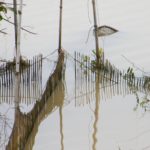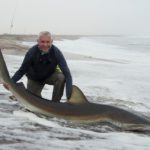In the following, we will briefly describe a specific speargun for freshwater fishing, which I bought from a fisherman in the northern suburbs of Bangkok, Thailand. It is neither as primitive as many of these guns are, nor is it too over-sophisticated. Besides the reel, everything was made locally by himself and just for the practical purpose of catching fish for his family’s table.
General description
With a total length of 186cm / 6 ft 1.23’’ (73 ¹⁵/₆₄’’), this is a pretty long piece of equipment. But it can be easily handled from an elevated position over water, where there are no obstacles around. The main components of this speargun are:
- Wooden stock, which also acts as the guideway for the spear
- Rubber bands with fastening bar
- Trigger mechanism
- Reel and line on mounting brackets
- The spear


Wooden stock
The stock assures convenient handling of the speargun. It is made from straight-grown teak heartwood. To close the wood pores and make it water resistant, the stock was varnished after the final assembly of all parts.

The guideway (or guiding groove) for the spear is often called ‘barrel’ – like at a real gun. But it is not a barrel, as it is open on the upper side. The length of this guideway from the hooking point of the rubber band wishbone to the muzzle is 120cm / 47’’. The width of the groove is 6mm over the whole length. The depth of the groove is 5mm / 13/64’’ at the hooking point and tapers up to 3mm / 1/8’’ at the muzzle end. With a spear thickness of 4mm / 5/32’’ over its whole length, the spear has got a tolerance of 1mm / 3/64”on either side within the groove, when propelled forward.
The reason why the spear flies straight
Here we can see the necessity of a long guideway. When the spear is released at its backward position, the rubber bands convert their stored potential energy into kinetic energy. Friction on the sidewalls would reduce this kinetic energy. To reduce friction, a wider groove was chosen compared to the spear thickness. But the spear will snake around sideward when propelled forward. When rubbing on the wall, friction is created, and the spear moves to the other side. And does the same on the opposite side.
At a good length of the guideway, this sideward snaking will be reduced, and the spear will take the path of least resistance – which means moving straight horizontally in between the sidewalls. A vertical movement of the spear is not possible due to the eccentric location of the hooking point. This assures that the spear is always pressed to the guideway bottom. And is further reduced by the tapering-up of the groove bottom.
Stock decoration
On both sides of the stock of the speargun for freshwater fishing, a picture of a Thai mystical figure was added for spiritual purposes. The head of the same figure is depicted on both sides of the forend. Depicted is the ‘Respected Mighty Hermit Dern Deng’ (Thai: พ่อแก้วเลอซี่เดินเด่น, Por Gae Lersi Dern Deng).
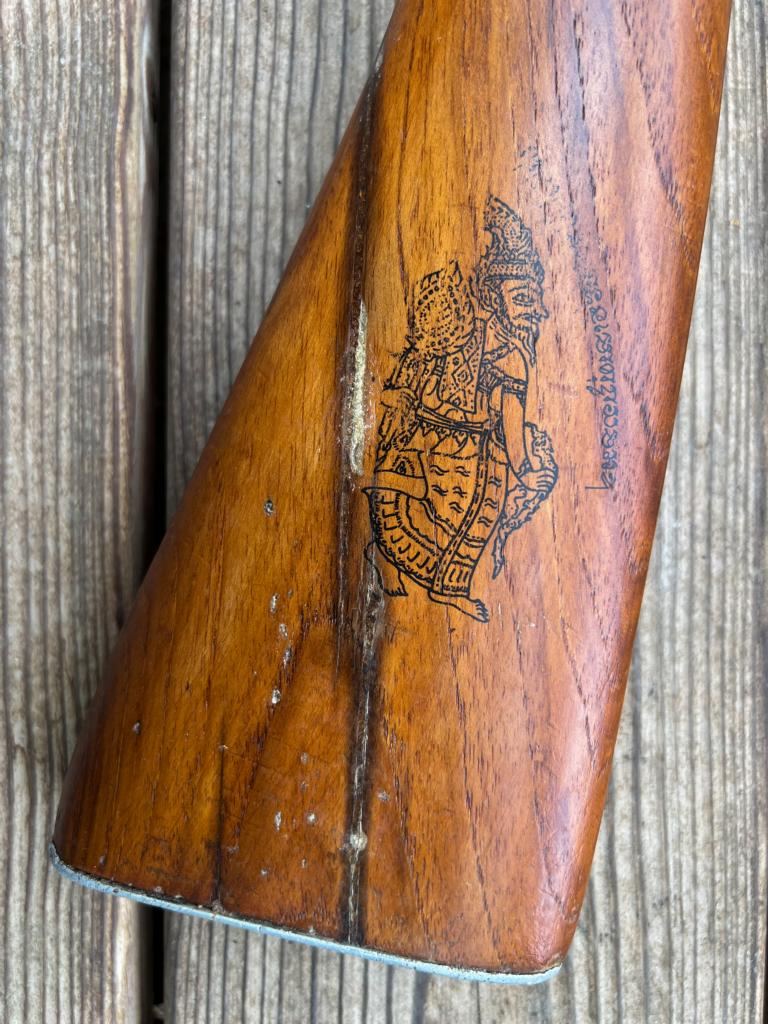


In Thai folklore, Lersi (yogi or ascetic hermit) Dern Dong is believed to possess various supernatural powers, including:
- Control over the elements of fire, wind, and rain, and can use these powers to create or destroy.
- Healing abilities: it is believed he has the power to cure physical and spiritual ailments.
- Lersi Dern Dong is believed to possess great knowledge and wisdom and is often sought out by those seeking guidance or answers to spiritual questions.
- He is also considered a protector and is often invoked for protection from harm or danger.
All-in-all, Lersi Dern Dong is revered as a powerful and wise hermit with a wide range of supernatural abilities. The builder of this speargun considered him a suitable protector of the bearer and his gun.
Rubber band tubes with fastening bar
Distance from the hooking point of the spear locked in the gun to the fastening bar is exactly 1m / 39’’. The distance of the fixation points of the rubber band tubes from the forend is 9cm / 7.5’’ on either side of the forend wooden walls. The total distance between both fixation points is 20,5cm (9 + 2,5 +9) / 8’’.



The rubber bands have a tube shape with an outer diameter of 12mm / 15/32’’ and a wall thickness of 3mm / 1/8’’. The wishbone between both rubber band tubes is made from a densely woven, strong polyester band with a total open length of 16cm / 6’’. Both rubber band tubes are connected to the fastening bar with the same type of polyester material.
Trigger mechanism
Also, the trigger mechanism is homemade. It works as follows: A round tap locks into a hole in the rear end of the spear. When the tap is vertically moved downwards, the spear is getting released.
The vertical downward movement of the tap is initiated by a lever, which is a fixed part of the trigger. This lever connects to a cam at the lower end of the tap. The tap will be pushed upwards again by a spring below the cam. Therefore, pulling the trigger will move down the tap, release the spear, and be put back in the initial position by a spring. There are only two moving mechanical parts and a coil spring. The whole mechanism is held together by a trigger plate and secured by a trigger guard.
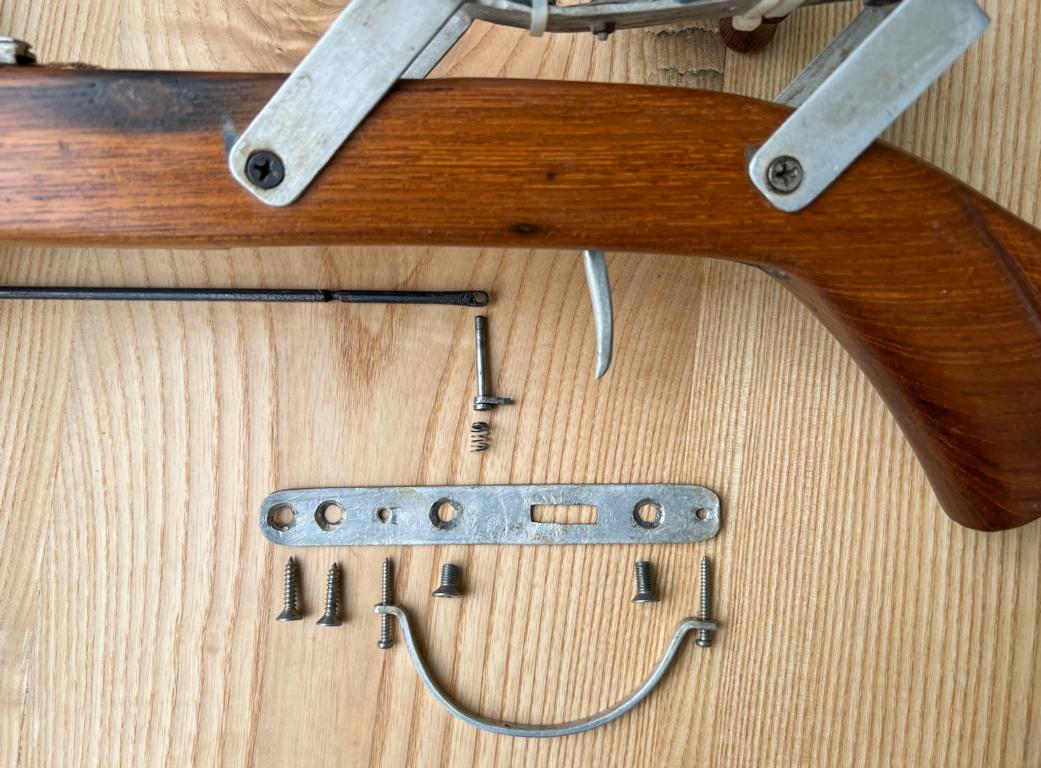


Reel and line
A ‘Closed face’ spin cast reel is mounted on two aluminum brackets above the stock. It looks like the mounting brackets were intentionally angled backward and not by an accident or outside pressure. The spin cast reel bears the name and logo of the ‘Marukyu’ brand. The gear ratio is 4.1:1, which is impressive for such a simple reel. Most of these reels got ratios of either 3.1:1 or 3.3:1.
The fishing line has a thickness is 0,4mm / 1/64’’ in monofilament. The distance from the knot around the spear and the mono-line is bridged by a 20cm / 8’’ long double-braided nylon twine. The purpose of this twine is increased protection against abrasion at the spear cover bracket in front of the reel bracket.
Spear
The so-called ‘spear’ is an arrow with a latching hook on it. The length of this spear is 29cm / 11.4’’ with a uniform thickness of 4mm / 5/32’’. It has a sharp, pointed nose and a latching hook 4cm / 1.6’’ behind the tip. The rear end has a hole for the trigger tap. About 5cm / 2’’ from the rear end there is a constriction, which is holding the braided line. Spear material is mild steel, and the latching hook was welded on in Inox.

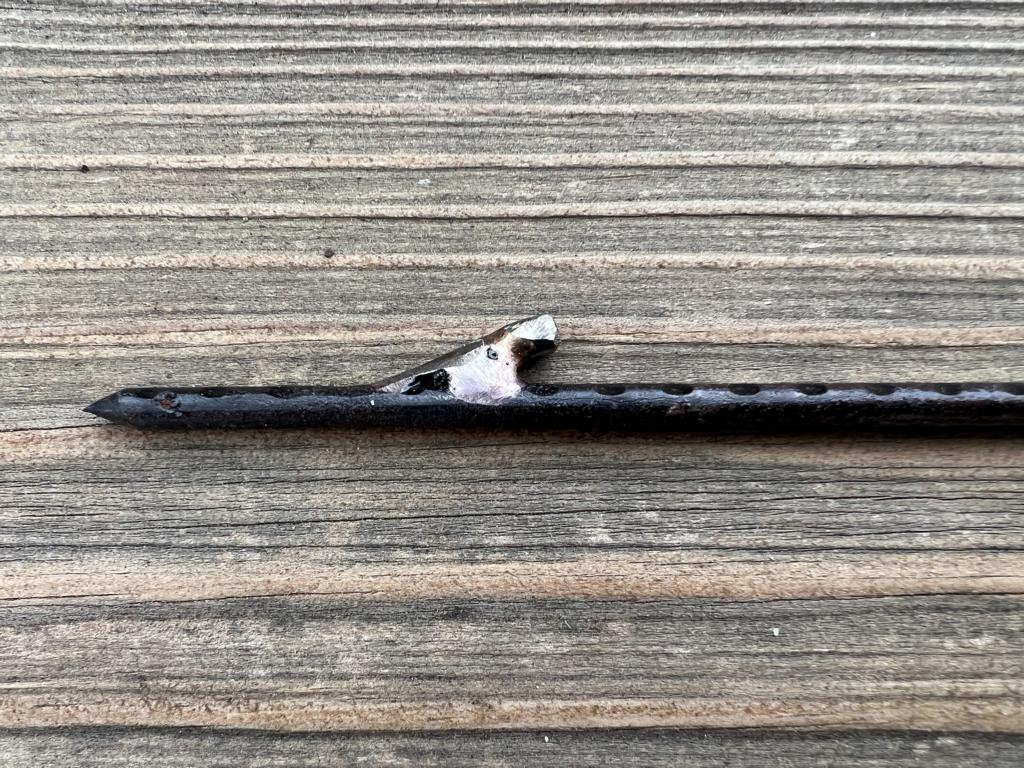

Loading and shooting
The speargun for freshwater fishing is loaded by connecting the rear end hole of the spear to the trigger tap and fastening the line by the reel. In preparation for shooting, the clutch button on the reel has to be pressed. By that, the line can be spooled off freely when shooting. After hitting the target, the arrow is often completely penetrating through the fish and the target can be reeled in easily.

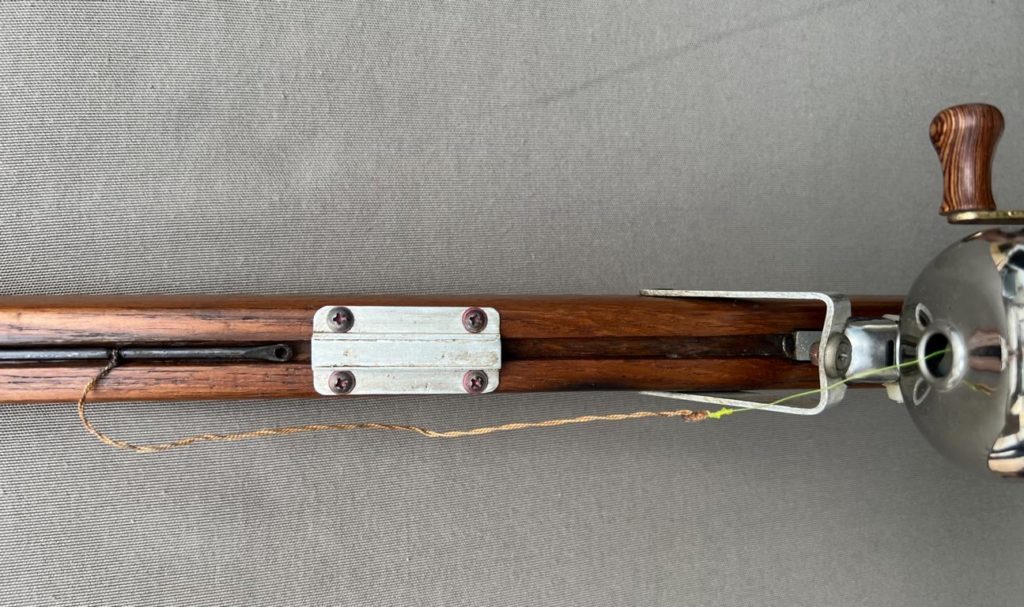
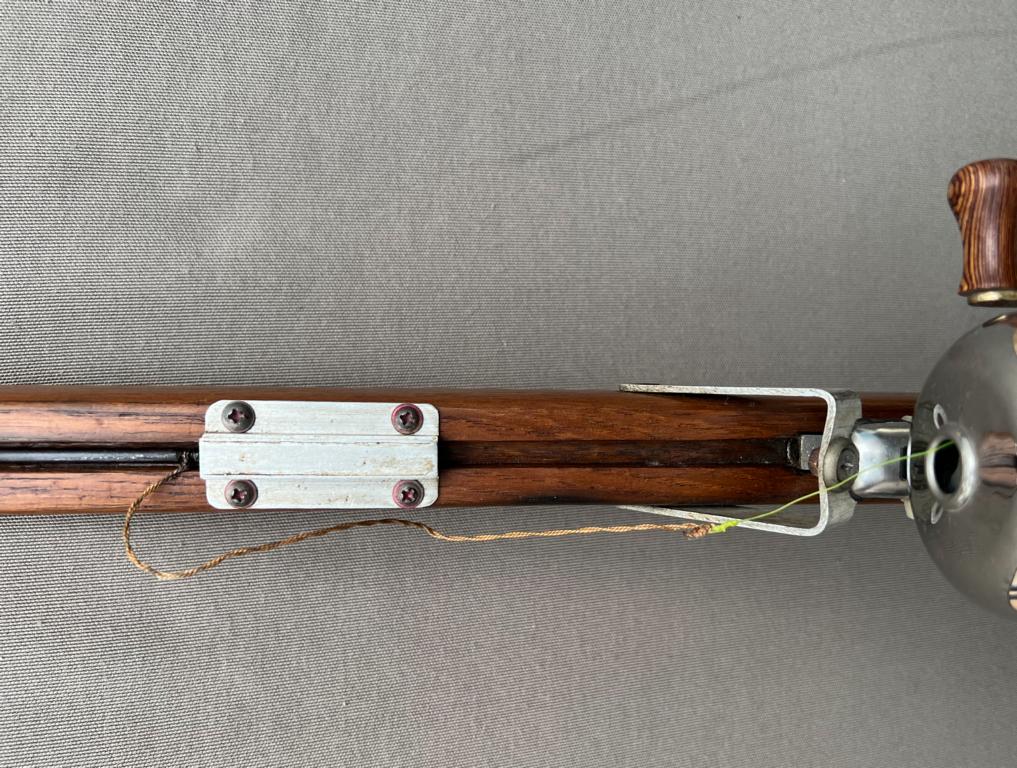

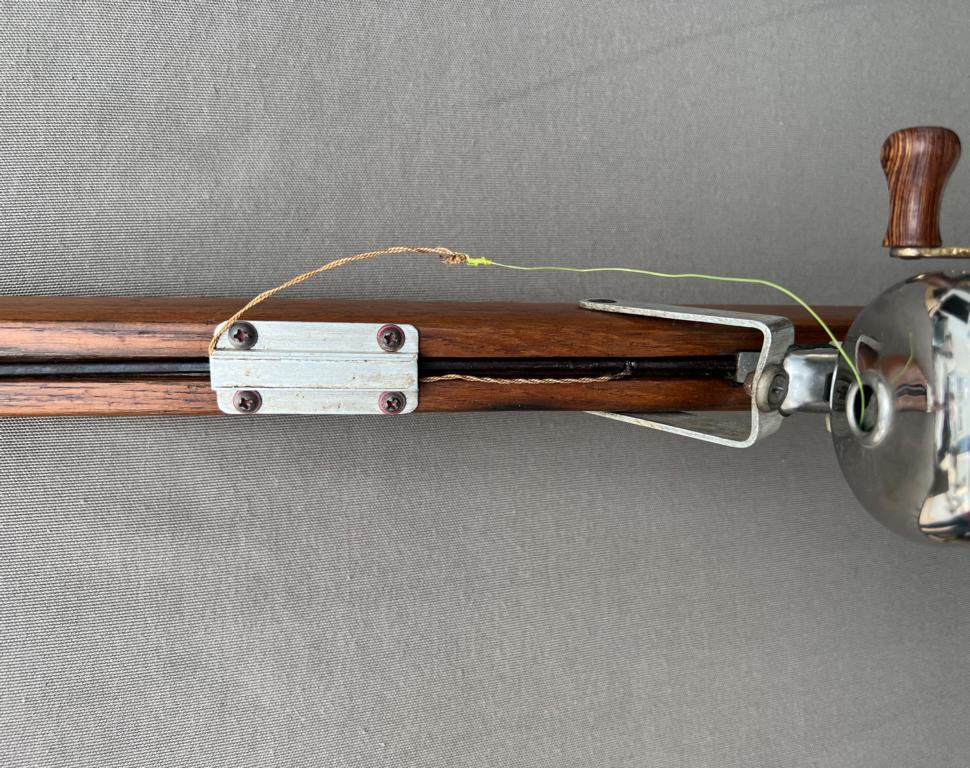

Aiming
Unobstructed aiming of the gun on a target is difficult, as there is always the latching hook with the wishbone band in the line of sight. However, due to the long wooden guideway, it is possible to level the upper surface of the wooden forend with the horizon of the muzzle and the target. And it can be seen in practical fishing applications of such spearguns, that the likelihood of striking fish is high.
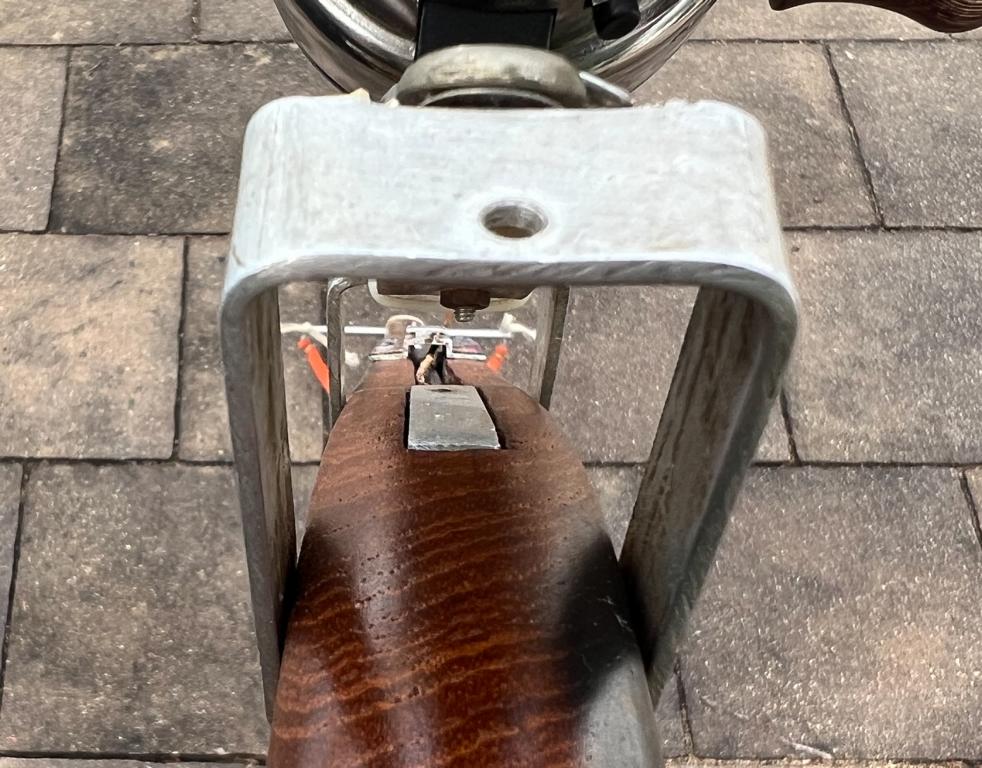
Lessons learned about a homemade speargun for freshwater fishing:
- Presented speargun for freshwater fishing in Thailand is 1,86 m / 6 ft 1.23’’ long but still lightweight and easy to handle.
- All parts, except the reel and line, are handmade.
- For spiritual protection of the bearer and gun, stencils of the ascetic hermit Dern Dong were added to stock and forend.
- Exact aiming at a target is difficult, as the latching hook of the spear and the wishbone band are in the line of sight.
.


